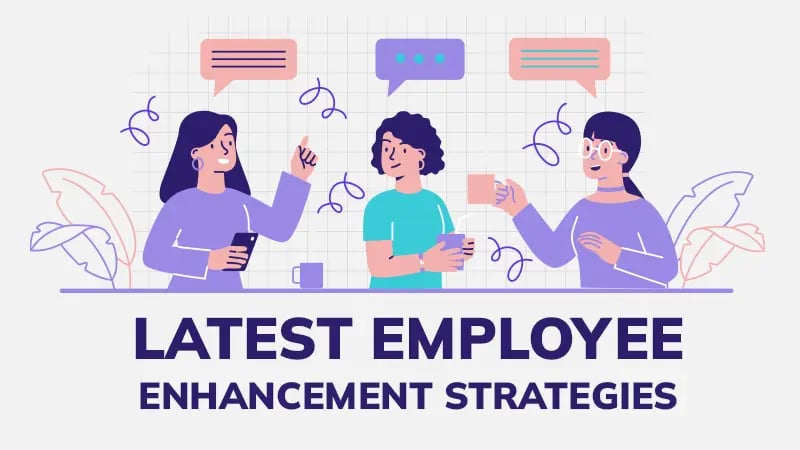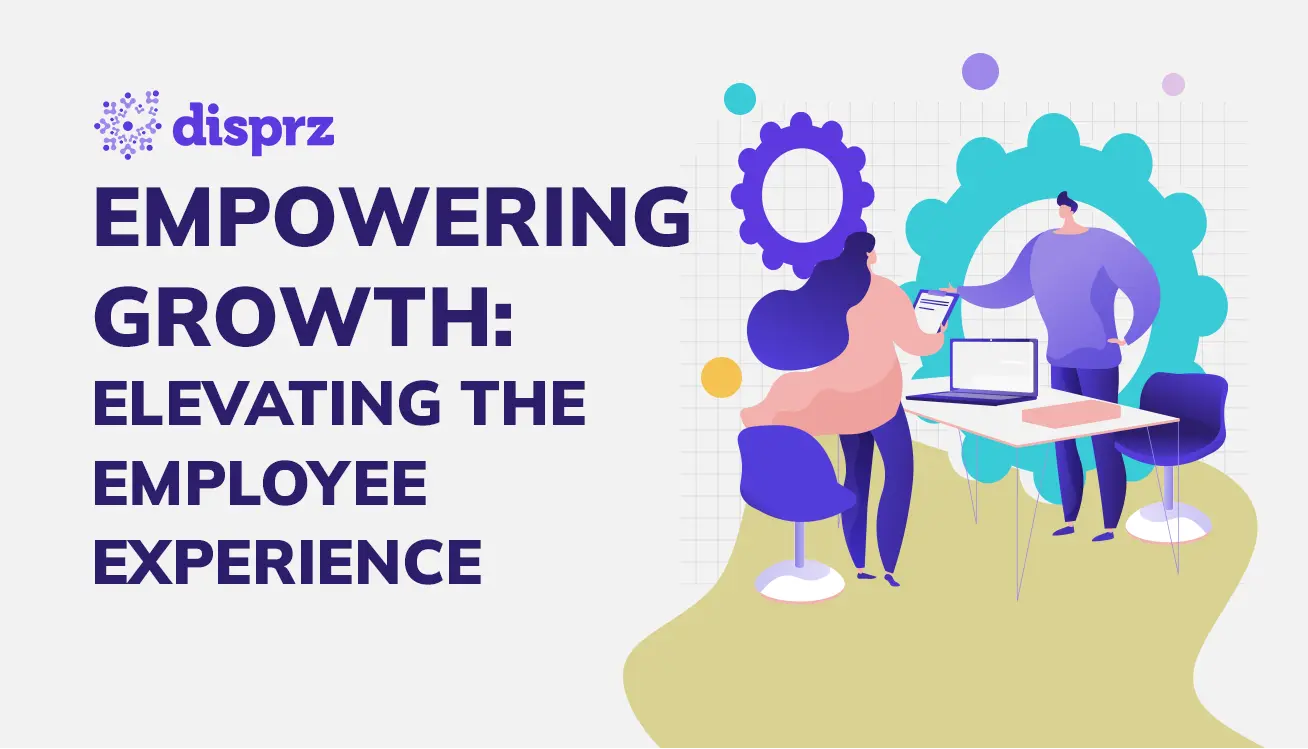In today's competitive business landscape, organizations are realizing the critical role that employee experience plays in driving organizational growth. The latest data on employee engagement from Gallup indicate just 32% of full and part-time employees are engaged at work, while 18% are actively disengaged. All of this disengagement underscores why there’s been so much concern in recent months over employees “quietly quitting” at work, or simply going through the motions until they find a new gig.
As these facts highlight the pressing need to tackle professional experience challenges in the workplace, it becomes essential to seek expert assistance. This is where Disprz comes into play. Continuously, it has enabled organizations across diverse industries to boost their experience as employees.
With our expertise in this domain, we are uniquely qualified to lead you through established strategies for increasing the experience of the employee, thus propelling your business toward unparalleled success.
What is Employee Experience?
Employee experience measures the level of comfort and happiness your employees feel at work. The experience of an employee is more concerned with the contentment, wellness, and sentiments that employees have about their roles and employer than employee engagement, which gauges the sense of connection employees have with one another and their place of employment.
Why is Employee Experience Important?
Personnel experience encompasses every interaction an employee has with their organization, from the initial recruitment process to daily work routines and career development opportunities. It circumscribes the factors such as work environment, leadership practices, professional development initiatives, work-life balance, and digital workplace technologies.
A positive Professional experience as an employee is essential for several reasons
Employee Engagement
According to data from Statista, employee engagement stood at 67 percent in 2022 and 2023. It was at its highest in 2020 when it reached 69 percent. A culture of inclusivity that appreciates employee contributions improves heightened engagement and satisfaction among the workforce. When employees perceive that their opinions are acknowledged and honored, they become more inclined to be motivated, dedicated, and devoted to the organization. Consequently, this diminishes turnover rates and augments overall employee retention, thereby bolstering sustained organizational prosperity.
Organizational Performance
Employees are more inclined to put in their best effort to achieve organizational objectives when they feel appreciated and supported. An environment that encourages creativity, teamwork, and operational excellence boosts an organization's success as a whole.
Talent Attraction and Retention
A recent study by Deloitte revealed compelling insights about the employees who reported an exceptional employee experience were three times more likely to perceive their organization as customer-focused and one and a half times more likely to derive satisfaction from direct interactions with customers and clients. Therefore, organizations offering an exceptional experience that an employee gains a competitive edge in attracting and retaining top talent in today's cutthroat labor market. Establishing a reputation as an employer of choice not only aids in recruitment efforts but also mitigates turnover costs.
Workplace Culture
A team member’s experience shapes the organizational culture, influencing norms, values, and behaviors within the workplace. A positive culture characterized by trust, transparency, and inclusivity helps employee satisfaction, morale, and long-term loyalty.
How to Enhance the Employee Experience in 2025
Here are some essential strategies to enhance the professional experience of an employee

Cultivating a Positive Work Environment
Enhancing the work environment should prioritize raising a positive and inclusive atmosphere. Leaders need to place a high value on candid communication, openness, and teamwork. Acknowledging and applauding employee accomplishments also enhances the good work atmosphere. This can be achieved by fostering regular communication channels where employees feel comfortable sharing their ideas and concerns, promoting collaboration among team members through team-building activities and cross-functional projects, and implementing recognition programs to celebrate individual and team achievements. Additionally, creating policies and practices that promote diversity, equity, and inclusion ensures that all employees feel valued and respected in the workplace.
Prioritizing Work-Life Balance
Achieving a positive work-life balance is essential for the happiness and well-being of employees. Businesses can help with this by providing flexible work schedules or remote work alternatives. Encouraging workers to put away their work during off-peak hours enhances general well-being and averts burnout.
Investing in Professional Development
Employee growth and advancement can be demonstrated by giving opportunities for continuous learning and skill development. Employees are empowered to grow in their careers inside the company by receiving training, opportunities for mentorship, and career development resources.
Seeking Employee Feedback
Organizations may find areas for improvement and make the necessary changes to improve the employee engagement by routinely asking employees for their feedback. Implementing employee feedback mechanisms, such as surveys or focus groups, demonstrates a commitment to listening to employees’ voices and addressing their concerns.
Embracing Digital Workplace Technologies
With the appropriate technology in place, team leaders can seamlessly deliver urgent messages to a wide audience, foster cross-departmental communication, effectively improve the skills of all employees, and utilize comprehensive 360-degree assessment data to track and enhance employee performance.
Josh Bersin Employee Experience Case Study Report
Josh Bersin and the team conducted a study on employee experience and came up with an in-depth Report, The Definitive Guide- Employee Experience.
Below are the key excerpts from the report that focuses on employee experience:
-
Drive agility and support employees to deal with ambiguity.
-
Reinvent learning practices and speed up performance management.
-
Cultivate a positive work culture where employees can grow their careers and skills.
-
Take ongoing actions to provide a great employee experience.
-
To attract talent, it is imperative to become an irresistible organization that people would love to join.
-
The right tools and support can help you become an irresistible organization.
-
Collaboration platforms, knowledge management systems, and in-the-flow learning apps enable remote and flexible work.
-
Focus on trust, transparency, inclusion and care
-
Motivate employees to continuously develop regardless of their role
-
Have a people-first approach and encourage employees to bring their authentic selves to work.
When companies make the mission and purpose part of all work, they are 4.3 times more likely to meet or exceed financial targets and 4.8 times more likely to satisfy and retain customers.
How to Measure Employee Experience in 2025
Measuring workforce experience involves evaluating various aspects of the employee journey and collecting feedback to identify strengths, weaknesses, and areas for improvement. Key metrics for measuring employee experience include:

Employee Engagement Surveys
Regular surveys assess employee perceptions, satisfaction levels, and engagement with organizational policies and practices. These surveys measure factors such as job satisfaction, leadership effectiveness, and opportunities for professional development.
Employee Satisfaction Scores
Feedback mechanisms, such as pulse surveys or annual satisfaction surveys, provide insights into overall employee satisfaction levels and identify specific areas of concern or improvement.
Retention Rates
According to the Deloitte report, organizations with a strong learning culture have 30%-50% higher engagement and retention rates. Monitoring turnover rates and analyzing reasons for employee departures helps assess the effectiveness of the personnel experience. High turnover rates may indicate underlying issues with the workplace culture, leadership practices, or career development opportunities.
Work-Life Balance Metrics
Evaluating metrics related to work-life balance, such as utilization of flexible work arrangements, employee wellness program participation, and average working hours, provides insights into employees' ability to maintain a healthy balance between work and personal life.
Leadership Effectiveness
Assessing leadership practices, including communication effectiveness, accessibility of leaders, and alignment with organizational values, is crucial for understanding their impact on employment experience and employee engagement.
Digital Workplace Metrics
With the rise of remote and hybrid work environments, metrics related to digital workplace experiences, such as technology adoption rates, collaboration tools utilization, and employee satisfaction with remote work arrangements, are increasingly important.
Conclusion
The significance of employment experience in driving organizational success cannot be overstated. As businesses recognize the critical link between employee satisfaction, engagement, and overall performance, investing in strategies to enhance the employee experience has become imperative.
In this discussion, the multifaceted dimensions of personnel experience are explored, encompassing the promotion of a positive workplace culture, provision of opportunities for professional development, and ensuring work-life balance. Additionally, the significance of leveraging technology, such as Disprz's AI-powered Learning Experience platform, to facilitate continuous learning, skill development, and employee engagement is underscored.
By prioritizing workplace experience, organizations can create an environment where employees feel valued, empowered, and motivated to perform at their best. With tools and support from platforms like Disprz, organizations can effectively measure, analyze, and improve the experience of the personnel, ultimately driving productivity, innovation, and organizational success.
As businesses navigate the complexities of today's competitive landscape, embracing a holistic approach to enhancing employee experience is key to unlocking the full potential of their workforce. By prioritizing employee well-being, enriching a culture of continuous learning and development, and leveraging technology to facilitate engagement and collaboration, organizations can position themselves for sustained success and growth in the long term.








